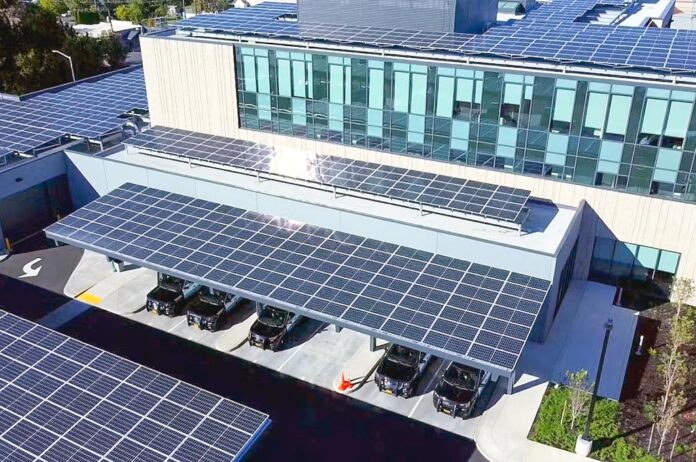
Plans for a $4 million solar capture, storage, and generator system at the Tigard Library could put the city at the forefront of emerging microgrid technology, enabling the building to one day power itself during outages and feed energy back into the wider network.
The proposed combination of rooftop and parking lot solar panels to harness energy, a high-capacity battery to store it, and a generator to distribute it will make the building a self-sufficient island that can continue operations as a warming or cooling during power outages.
It’s envisioned as the starting point for what will eventually be a larger interconnected microgrid network that could include a nearby neighborhood and a bridge spanning Fanno Creek.
City Council, meeting virtually during a January ice storm that punctuated the value of backup power systems, unanimously supported the project, asking city officials to pursue funding.
Part of that money will come from a partnership with PGE, which collaborated with Beaverton on a similar project at the Beaverton Public Safety Center. The building houses its police department and emergency management program.
The city is also partnering with the Energy Trust of Oregon.
“We’re starting to see this multivariable approach with how grids and buildings interact,” said PAE lead project engineer Karina Hershberger.
Microgrids are localized mini-grids that can connect and disconnect with the larger power grid, allowing buildings, neighborhoods, or whole regions to operate completely interconnected or as independent islands, the way a house or larger building can run autonomously with a gas generator.
Unlike gas generators and traditional utilities, energy from the microgrid can flow back to the larger grid. During long summer days, when the library collects more power than it can use and store, the excess would flow back to PGE.
Hershberger, whose home had been without power for four days, was using a hotspot and batteries to join the meeting.
“As our region is probably, unfortunately going to be experiencing more and more of this kind of extreme weather conditions, we need to be thinking differently about how our energy systems are structured,” she said.
Tigard Senior Planner Gary Pagenstecher said the library’s capacity to house rooftop solar panels with additional space for adding both solar carport canopies and an on-site battery system, plus a viable way to tie into the existing electrical system, made it an appealing place to start.
The project is a step toward reaching city resiliency and climate goals to drastically reduce Tigard’s greenhouse gas emissions and be carbon neutral by 2050.
Tigard partnered with University of Oregon graduate students from the Sustainable City Year Program on a feasibility study to explore the potential of constructing a multi-tiered system of interconnected mini-grids in the city.
This first phase dovetails with ongoing HVAC and lighting upgrades to the library.
“Provisions for the future Microgrid system have been incorporated within facilities currently underway at the library,” a report on the project said. “The scope of this coordination provides space and pathways for future electrical components needed for a Microgrid system.”
Pagenstecher said the finished library project will also create interactive displays for visitors to learn about the microgrid and see the building’s energy usage in real-time, including which direction energy is flowing.
“When the microgrid is up and running, there will be an interactive monitor in the library lobby, so the learning tools will be expanded (to include) the real-time ability to observe power generation and use,” he said. “There’s a panel, like that in the Beaverton Safety Center, which is very effective.”
The city is currently seeking grant funding from FEMA, The Oregon Department of Energy, and other sources, with a target of beginning installation in 2025.





















